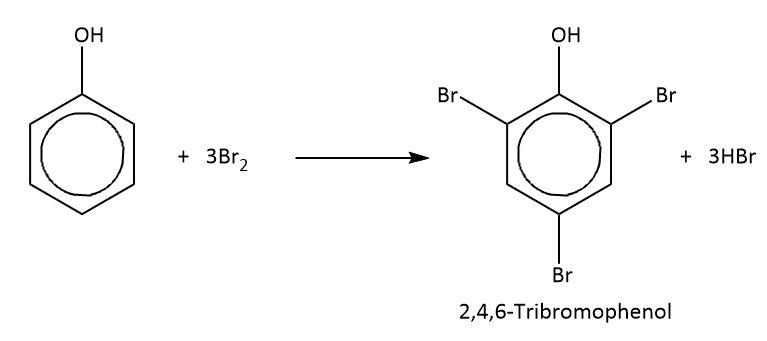
When phenol is treated with bromine water, the product formed is:
A.
B.
C.
D.
Answer
495.6k+ views
Hint: We know that the reaction of phenol with halogen is commonly termed as halogenation reaction. The reaction of phenol with bromine water results in the formation of polyhalogen derivatives.
Complete step by step answer:
It is known to us that if we add bromine water to a solution of phenol. The discoloration of bromine water occurs and the formation of white precipitate takes place. The white precipitate is
As the substitution is initiated by using an electrophile, the reaction is named as electrophilic substitution. Depending on the electrophile used, ortho, meta or para substitution takes place. The para substitution is favored the most as there will not be any steric hindrance. Electrophilic substitutions in lower temperature prefer para substituted product over ortho product.
The reaction of phenol with bromine water is shown below.

Hence, we can say that, when phenol is treated with bromine water, the product formed is
Thus, the correct option is D.
Note:
As we know that, aromatic compounds undergo electrophilic substitution reactions where an electrophile with a positive charge attacks the ring. The substitution can take place in ortho, meta, or para positions in the ring.
Complete step by step answer:
It is known to us that if we add bromine water to a solution of phenol. The discoloration of bromine water occurs and the formation of white precipitate takes place. The white precipitate is
As the substitution is initiated by using an electrophile, the reaction is named as electrophilic substitution. Depending on the electrophile used, ortho, meta or para substitution takes place. The para substitution is favored the most as there will not be any steric hindrance. Electrophilic substitutions in lower temperature prefer para substituted product over ortho product.
The reaction of phenol with bromine water is shown below.

Hence, we can say that, when phenol is treated with bromine water, the product formed is
Thus, the correct option is D.
Note:
As we know that, aromatic compounds undergo electrophilic substitution reactions where an electrophile with a positive charge attacks the ring. The substitution can take place in ortho, meta, or para positions in the ring.
Recently Updated Pages
Basicity of sulphurous acid and sulphuric acid are

Master Class 12 Economics: Engaging Questions & Answers for Success

Master Class 12 Maths: Engaging Questions & Answers for Success

Master Class 12 Biology: Engaging Questions & Answers for Success

Master Class 12 Physics: Engaging Questions & Answers for Success

Master Class 4 Maths: Engaging Questions & Answers for Success

Trending doubts
Give 10 examples of unisexual and bisexual flowers

Draw a labelled sketch of the human eye class 12 physics CBSE

a Tabulate the differences in the characteristics of class 12 chemistry CBSE

Differentiate between homogeneous and heterogeneous class 12 chemistry CBSE

Why is the cell called the structural and functional class 12 biology CBSE

Differentiate between insitu conservation and exsitu class 12 biology CBSE




